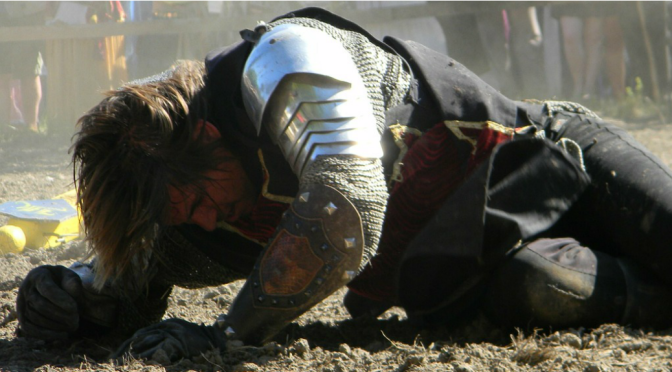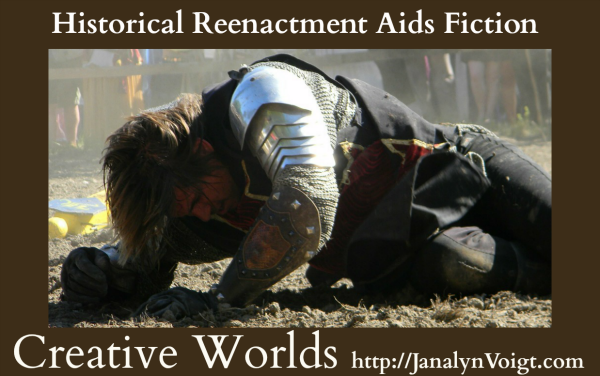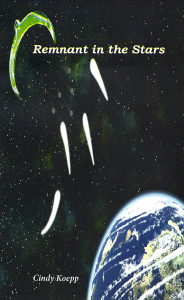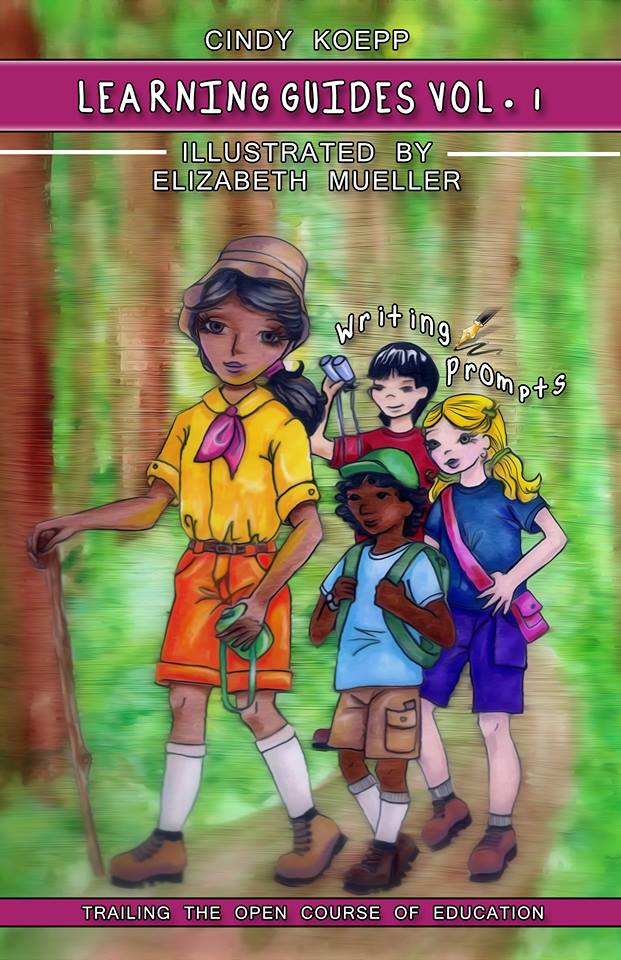Cindy Koepp and I have been chatting online for years now, and I’ve grown fond of her. One thing that Cindy and I have in common, besides a love of fantasy books, is that we both spent time as members of the Society for Creative Anachronism. Cindy became a fighter, whereas I was a bard singing medieval lays. I agree with the point she makes in her guest post.
Janalyn Voigt
Historical Reenactment Aids Fiction
by Cindy Koepp
Historical reenactment and historical re-creation groups vary in their levels of authenticity. Some focus on an accurate replication of the historical events, and anything less than complete authenticity is shunned. For others, anything remotely close is good enough. Some groups have smaller subgroups that vary in their authenticity.
Fighting in the Society for Creative Anachronism
When I got to college, I found out about a historical re-creation group: The Society for Creative Anachronism (SCA). I joined up and got into what the SCA calls “light fighting,” rapier combat simulation using fencing gear. The group I played with studied a couple 16th and 17th century fencing forms.
One, an Italian form called DiGrassi, was actually pretty easy to pick up. The footwork was straightforward. The blade work was a bit tougher, but I got the hang of it over the span of a year or two. We had access to a translated manual, so that made it easier to learn.
The other form was a Spanish one, La Destreza, which is more erect and much harder to learn. The only manuals were written in 17th Century Spanish, which has little in common with modern Spanish. Even native Spanish-speakers said it was like trying to read Shakespeare in its original grammar, syntax, and spelling. Still, a few of us gave it a try based on pictures, what little Spanish we could translate, and some well-reasoned extrapolation. We were never really sure we got more than the basics, but we had a grand time, and I learned a lot.
Reenacting the Battle of San Jacinto
I had been in the SCA for a while when a couple of my friends met some of the folks who reenact the Battle of San Jacinto. That battle was the last in the Texas Revolution. After the Battle of the Alamo and the Goliad Massacre, Texas citizens and military gathered near what is now Houston, Texas. Sam Houston spent the time training the men to fight and scout while Mexican General Antonio Lopez de Santa Anna chased fleeing Texians, the proper name for Texans at the time, across the state. He finally arrived with a much superior force near where Houston’s forces were camped. The Mexican troops were resting when Houston began the attack. Fewer than twenty minutes later, Mexico had been defeated.
The yearly reenactment was part of a public celebration of Texan Independence Day. The reenactors my friends met were the pyrotechnics crew, and they needed a few extra hands to make the cannon shots more realistic. They supplied us with appropriate costumes, and we helped with the explosions.
The reenactors had the muskets already taken care of. They used loads that were only cotton patches and gunpowder. Lots of BANG! but no metal ball. The troops on the opposite side could fake being shot and fall over if they wanted to.
The cannons were a bit trickier. The pyrotechnic crew planted small charges in the field on both sides. The cannon crews would fire blanks just like the muskets, then the pyro crew waited a few seconds and detonated one of the small charges on the opposite end of the field. The charges were covered were loose dirt and cork to create some debris, and the chalk outlines warned the reenactors about safe zones.
The second day, after a smaller battle was staged as a demonstration, one of the reenactors had a few blank charges left. He gave me an opportunity to load and fire his musket. Those things are heavy. I couldn’t hold the gun at shoulder height without something to brace it on.
Historical Reenactment as Book Research
Later, when disabilities and my day job caught up to me, I had to leave the SCA and other efforts at reenactment, but I found a use for all that otherwise esoteric knowledge. I write science fiction and fantasy. My fantasy tales tend to be set in a Renaissance type of setting, so some of my characters naturally ended up using rapiers.
I often use the Italian fencing form for one culture and the Spanish form for a different one. For one book, I used what I knew of rapier combat to invent a third, rather flashy but somewhat impractical style. It suited what I needed.
The San Jacinto re-enactment played an interesting part in my fantasy tales as well. The Renaissance setting involve black powder weapons. Although I did do a bit of research to verify what I remembered, I used that experience to describe characters using different kinds of pistols and muskets.
The reenactment groups I played with could be a little particular with the research details, but now, I find that most helpful. What I learned helps my writing, and – I hope – makes for interesting reading.
About Cindy Koepp
 Cindy Koepp is originally from Michigan. She moved to Texas as a child and later received a degree in Wildlife Sciences and teaching certification in Elementary Education from rival universities. Her current adventures in education include pursuing a master’s degree in Adult Learning with a specialization in Training and Performance Improvement. Cindy has a published science fiction novel called Remnant in the Stars, a serial published online called The Condemned Courier, and a few teacher resource books. When she isn’t reading or writing, Cindy spends time whistling with a crazy African Grey. Cindy is currently an editor with PDMI Publishing and Barking Rain Press.
Cindy Koepp is originally from Michigan. She moved to Texas as a child and later received a degree in Wildlife Sciences and teaching certification in Elementary Education from rival universities. Her current adventures in education include pursuing a master’s degree in Adult Learning with a specialization in Training and Performance Improvement. Cindy has a published science fiction novel called Remnant in the Stars, a serial published online called The Condemned Courier, and a few teacher resource books. When she isn’t reading or writing, Cindy spends time whistling with a crazy African Grey. Cindy is currently an editor with PDMI Publishing and Barking Rain Press.
Books by Cindy Koepp
Remnant in the Stars
Two hundred years ago, the Aolanian home world exploded and a remnant of survivors escaped. As their convoy combed the galaxy looking for a new world to colonize, they discovered Earth and were given permission to establish a temporary base while they continued their search for a new home world. When an Aolanian exploration vessel goes missing after transmitting a garbled distress call, the uneasy alliance between the humans and the Aolanians is put to the test as two anti-Aolanian groups jockey to use this opportunity to press their own agendas by foiling the rescue mission.
Because his daughter was onboard the Kesha when it vanished, Calonti Sora reluctantly signs on as an astrogator with the Gyrfalcon, one of the ships in the search party. There he meets up with an old human friend, Kirsten Abbott. Together, they work to overcome prejudice and political plots as they race toward an enemy no one could expect.
Purchase Remnant in the Stars by Cindy Koepp
Learning Guides, Vol. 1
What do bloggers, homeschoolers, teachers, and students all have in common? They need topics to write about. This book contains a lesson with examples on how to write a coherent essay followed by over 250 writing prompts. Some of the prompts are based on a quote from a famous person. Others are suggestions of topics including comparisons, speculative fiction, expository essays, persuasive essays, personal narratives. There’s even a section on math-related prompts and resource links for more quotes.





Thanks for letting me share your space today!
Hi, Cindy. I missed your comment when you made it, but you are welcome.